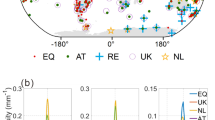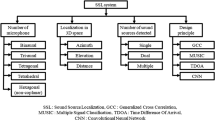Abstract
This paper studies the performance of angle of arrival algorithms for closely and widely separated signals. The study aims to examine algorithms behaviour when deployed to different scenarios. The investigated techniques include Bartlett beamformer, Capon beamformer, Multiple Signal Classification (MUSIC), Root-MUSIC, estimation of signal parameters via rotational invariant techniques (ESPRIT), and Weighted Subspace Fitting (WSF). The examined scenarios consider closely and widely angular separated signals, also, the effect of varying the number of antenna elements (N), the number of snapshots (K), and the noise power level (n) were studied. We generated MATLAB codes to simulate the algorithms, where the effect of changing one setting was taken individually, then the effect of changing more than one setting was considered. It was found that varying the number of antennas has a major impact on detection accuracy for all algorithms. Root-MUSIC and ESPRIT algorithms tend to have the best results in the investigated scenarios.



Similar content being viewed by others
Availability of Data and Materials
The data that support the findings of this study are available on request from the corresponding author.
Code Availability
Not applicable.
References
Zhang, M., Zhang, S., & Cao, J. (2008) Fusing received signal strength from multiple access points for WLAN user location estimation. In 2008 International conference on internet computing in science and engineering, 2008 (pp. 173–180).
Fouskas, K., Giaglis, G., Kourouthanassis, P., Pateli, A., & Tsamakos, A. (2002). On the potential use of mobile positioning technologies in indoor environments. In BLED 2002 proceeding (p. 33)
Hahn, J. (2017). Indoor positioning services and location-based recommendations. Library Technology Reports, 53(1), 9–16.
Calderoni, L., Ferrara, M., Franco, A., & Maio, D. (2015). Indoor localization in a hospital environment using random forest classifiers. Expert Systems with Applications, 42(1), 125–134.
Shuaieb, W., et al. (2020). RFID RSS fingerprinting system for wearable human activity recognition. Future Internet, 12(2), 33.
Nilsson, J.-O., Rantakokko, J., Händel, P., Skog, I., Ohlsson, M., & Hari, K. V. S. (2014). Accurate indoor positioning of firefighters using dual foot-mounted inertial sensors and inter-agent ranging. In 2014 IEEE/ION position, location and navigation symposium-PLANS 2014, 2014 (pp. 631–636).
Nirjon, S., Liu, J., DeJean, G., Priyantha, B., Jin, Y., & Hart, T. (2014). COIN-GPS: Indoor localization from direct GPS receiving. In Proceedings of the 12th annual international conference on Mobile systems, applications, and services, 2014 (pp. 301–314).
Fusco, G., & Coughlan, J. M. (2018). Indoor localization using computer vision and visual-inertial odometry. In International conference on computers helping people with special needs, 2018 (pp. 86–93).
Diaz, E. M., Ahmed, D. B., & Kaiser, S. (2019). A review of indoor localization methods based on inertial sensors. In Geographical and fingerprinting data to create systems for indoor positioning and indoor/outdoor navigation. Elsevier, 2019 (pp. 311–333).
Hsiao, C.-C., & Huang, P. (2008). Two practical considerations of beacon deployment for ultrasound-based indoor localization systems. In 2008 IEEE international conference on sensor networks, ubiquitous, and trustworthy computing (sutc 2008), 2008 (pp. 306–311).
Obeidat, H., Shuaieb, W., Obeidat, O., & Abd-Alhameed, R. (2021). A review of indoor localization techniques and wireless technologies. Wireless Personal Communications, 119, 1–39.
Farid, Z., Nordin, R., & Ismail, M. (2013). Recent advances in wireless indoor localization techniques and system. Journal of Computer Networks and Communications, 2013, 1–12.
Zekavat, R., & Buehrer, R. M. (2011). Handbook of position location: Theory, practice and advances (Vol. 27). Wiley.
Patwari, N., Ash, J. N., Kyperountas, S., Hero, A. O., Moses, R. L., & Correal, N. S. (2005). Locating the nodes: Cooperative localization in wireless sensor networks. IEEE Signal Processing Magazine, 22(4), 54–69.
Chen, H.-C., Lin, T.-H., Kung, H. T., Lin, C.-K., & Gwon, Y. (2012). Determining RF angle of arrival using COTS antenna arrays: A field evaluation. In MILCOM 2012–2012 IEEE military communications conference, 2012 (pp. 1–6).
Krim, H., Forster, P., & Proakis, J. G. (1992). Operator approach to performance analysis of root-MUSIC and root-min-norm. IEEE Transactions on Signal Processing, 40(7), 1687–1696.
Boustani, B., Baghdad, A., Sahel, A., & Badri, A. (2019). Performance analysis of direction of arrival algorithms for smart antenna. International Journal of Electrical and Computer Engineering, 9, 4873.
Waweru, N. P., Konditi, D. B. O., & Langat, P. K. (2014). Performance analysis of MUSIC, root-MUSIC and ESPRIT DOA estimation algorithm. International Journal of Electronics and Communication Engineering, 8(1), 209–216.
Chen, H., Hu, J., Tian, H., Li, S., Liu, J., & Suzuki, M. (2018). A low-complexity GA-WSF algorithm for narrow-band DOA estimation. International Journal of Antennas and Propagation, 2018, 7175653.
Oumar, O. A., Siyau, M. F., & Sattar, T. P. (2012). Comparison between MUSIC and ESPRIT direction of arrival estimation algorithms for wireless communication systems. In The first international conference on future generation communication technologies, 2012, (pp. 99–103).
Goli, S. & Elameer, A. S. (2018). Performance analysis of beam scan, MIN-NORM, music and Mvdr DOA estimation algorithms. In 2018 International conference on engineering technology and their applications (IICETA), 2018 (pp. 72–76).
Sanson, J., Gameiro, A., Castanheira, D., & Monteiro, P. P. (2018). Comparison of DoA algorithms for MIMO OFDM radar. In 2018 15th European radar conference (EuRAD), 2018 (pp. 226–229).
Muhamed, R. (1996). Direction of arrival estimation using antenna arrays. Virginia Tech.
Godara, L. C. (1997). Application of antenna arrays to mobile communications. II. Beam-forming and direction-of-arrival considerations. Proceedings of the IEEE, 85(8), 1195–1245.
Krim, H., & Viberg, M. (1996). Two decades of array signal processing research: The parametric approach. IEEE Signal Processing Magazine, 13(4), 67–94.
Foutz, J., Spanias, A., & Banavar, M. K. (2008). Narrowband direction of arrival estimation for antenna arrays. Synthesis Lectures on Antennas, 3(1), 1–76.
Jiang, Y., Stoica, P., Wang, Z., & Li, J. (2003). Capon beamforming in the presence of steering vector errors and coherent signals. In 11th Annual Workshop on Adaptive Sensor Array Processing (ASAP 2003), pp. 11–13.
Schmidt, R. (1986). Multiple emitter location and signal parameter estimation. IEEE Transactions on Antennas and Propagation, 34(3), 276–280.
Dhope, T. S. (2010). Application of music, esprit and root music in DOA estimation. Faculty of Electrical Engineering and Computing, University of Zagreb.
Li, J., Jiang, D., & Zhang, X. (2016). DOA estimation based on combined unitary ESPRIT for coprime MIMO radar. IEEE Communications Letters, 21(1), 96–99.
Viberg, M., Ottersten, B., & Kailath, T. (1991). Detection and estimation in sensor arrays using weighted subspace fitting. IEEE Transactions on Signal Processing, 39(11), 2436–2449.
Viberg, M., & Ottersten, B. (1991). Sensor array processing based on subspace fitting. IEEE Transactions on Signal Processing, 39(5), 1110–1121.
Liao, Y., Fu, C., & Mung’onya, E. M. (2019). 2D DOA Estimation of PR-WSF Algorithm Based on Modified Fireworks Algorithm. In International conference on artificial intelligence for communications and networks, 2019 (pp. 210–224).
B. BOUSTANI, A. BAGHDAD, A. SAHEL, A. BADRI, and A. BALLOUK (2018) Adaptive algorithm for smart antenna system. In 2018 6th International Conference on Multimedia Computing and Systems (ICMCS), 2018, pp. 1–5.
Tuncer, T. E., & Friedlander, B. (2009). Classical and modern direction-of-arrival estimation. Academic Press.
Funding
The author declares that they have no fund support on their research.
Author information
Authors and Affiliations
Contributions
HO conceptualized the paper’s idea, conducted the simulations and analysed the data and edited the manuscript.
Corresponding author
Ethics declarations
Conflict of interest
The author declares that he has no known competing financial interests or personal relationships that could have appeared to influence the work reported in this paper.
Additional information
Publisher's Note
Springer Nature remains neutral with regard to jurisdictional claims in published maps and institutional affiliations.
Rights and permissions
About this article
Cite this article
Obeidat, H. Performance Comparisons of Angle of Arrival Detection Techniques Using ULA. Wireless Pers Commun 126, 3611–3623 (2022). https://doi.org/10.1007/s11277-022-09881-x
Accepted:
Published:
Issue Date:
DOI: https://doi.org/10.1007/s11277-022-09881-x




